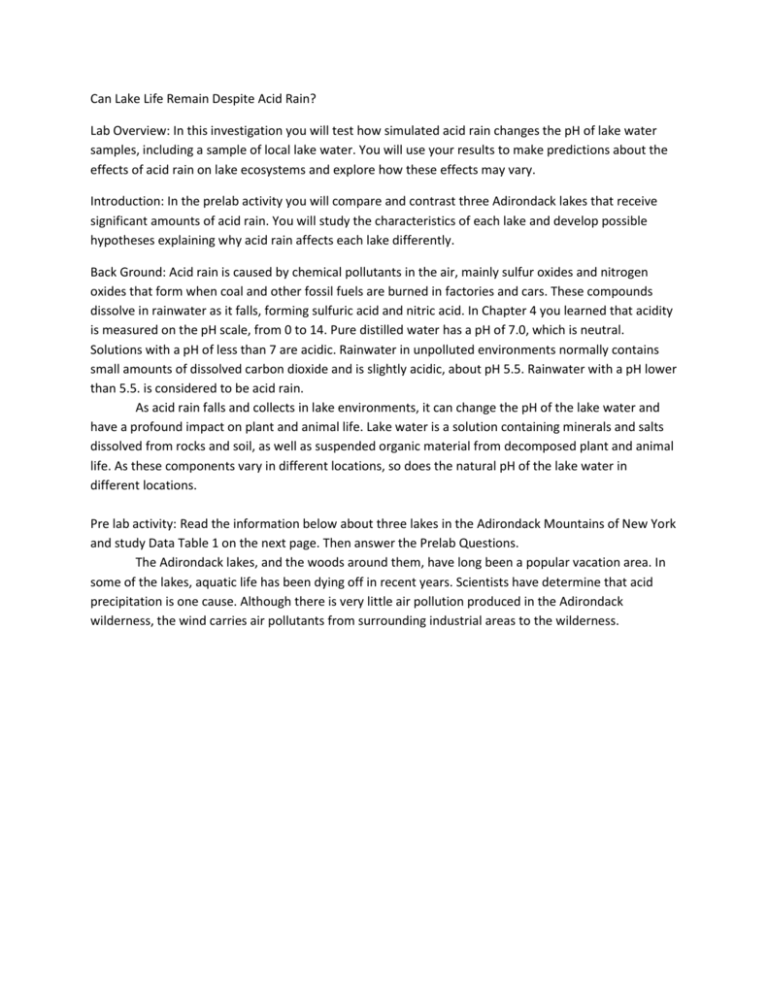Acid Rain & Lake Life: Lab Activity for High School
advertisement

Can Lake Life Remain Despite Acid Rain? Lab Overview: In this investigation you will test how simulated acid rain changes the pH of lake water samples, including a sample of local lake water. You will use your results to make predictions about the effects of acid rain on lake ecosystems and explore how these effects may vary. Introduction: In the prelab activity you will compare and contrast three Adirondack lakes that receive significant amounts of acid rain. You will study the characteristics of each lake and develop possible hypotheses explaining why acid rain affects each lake differently. Back Ground: Acid rain is caused by chemical pollutants in the air, mainly sulfur oxides and nitrogen oxides that form when coal and other fossil fuels are burned in factories and cars. These compounds dissolve in rainwater as it falls, forming sulfuric acid and nitric acid. In Chapter 4 you learned that acidity is measured on the pH scale, from 0 to 14. Pure distilled water has a pH of 7.0, which is neutral. Solutions with a pH of less than 7 are acidic. Rainwater in unpolluted environments normally contains small amounts of dissolved carbon dioxide and is slightly acidic, about pH 5.5. Rainwater with a pH lower than 5.5. is considered to be acid rain. As acid rain falls and collects in lake environments, it can change the pH of the lake water and have a profound impact on plant and animal life. Lake water is a solution containing minerals and salts dissolved from rocks and soil, as well as suspended organic material from decomposed plant and animal life. As these components vary in different locations, so does the natural pH of the lake water in different locations. Pre lab activity: Read the information below about three lakes in the Adirondack Mountains of New York and study Data Table 1 on the next page. Then answer the Prelab Questions. The Adirondack lakes, and the woods around them, have long been a popular vacation area. In some of the lakes, aquatic life has been dying off in recent years. Scientists have determine that acid precipitation is one cause. Although there is very little air pollution produced in the Adirondack wilderness, the wind carries air pollutants from surrounding industrial areas to the wilderness. Data Table 1 Characteristic Size (approximate) Elevation (approximate) Water Color pH Algae growth Phosphorus levels Nitrogen Levels Brant Lake 5.7 km2 243m Big Moose Lake 5.2 km2 556m Blue Mountain Lake 5.5 km2 545m Clear 7.6 Moderate Low Low Brown 5.5. Low Low Moderate to High clear 7.2 Low Low Moderate Prelab Questions 1. Which lake has the most acidic water? What physical differences does that lake have from the others? 2. An ecology student noticed that Big Moose Lake has a higher nitrogen level than Brant Lake, but has lower algae growth. This data surprised her, because algae often flourish in water with high nitrogen levels. Develop a hypothesis to explain the surprisingly low algae growth in Big Moose Lake. 3. In lakes with low pH, such as Big Moose Lake, the normal decomposition of plant and animal debris slows down. How might this explain the difference in appearance between Big Moose Lake and the other two lakes? 4. Graph the ph data for each lake, make sure to include a title, and axis labels (hint the graph type should not show time) Lab Activity Given the materials listed below, devise an activity that could test whether different bodies of water in your area contain high levels of acid. Make sure to write a question, hypothesis, prediction, and procedure. Data should be collected into a data table and then graphed. A conclusion should be written about your findings. Materials: 5 clear plastic cups Graduated cylinder Stirring rods Labeling tape 50 mL each of water from 4 different sources 50 mL of purified water Litmus testing strips Conclusion:










